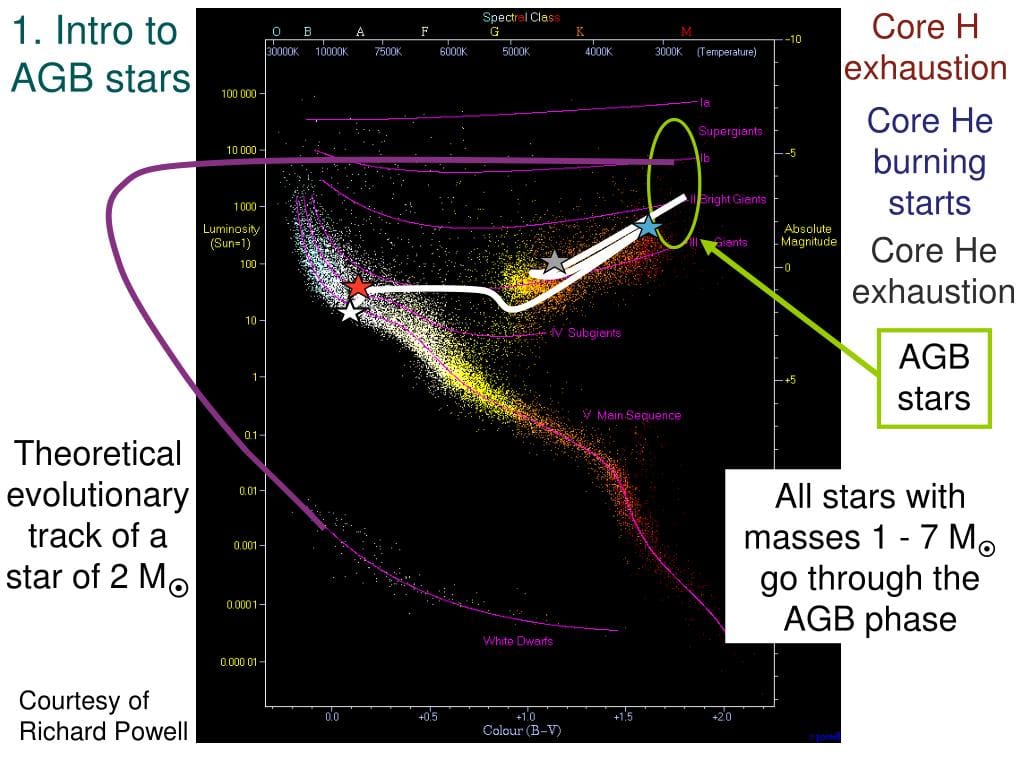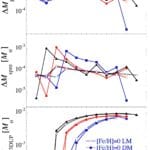Imagine a star nearing the end of its life, not with a bang, but with a cosmic sigh. It swells to an enormous size, glowing with a cool, reddish hue, its surface rippling with pulsating energy. This is an asymptotic giant branch (AGB) star, a celestial behemoth in its twilight years.
The Life and Times of Celestial Giants: A Star’s Journey to the AGB
AGB stars are fascinating objects, representing a critical stage in the life cycle of stars that are not massive enough to go supernova but are still hefty enough to undergo dramatic transformations. These are stars roughly between 0.5 and 8 times the mass of our Sun—in cosmic terms, the middle class of the stellar population.
After spending billions of years fusing hydrogen into helium in their cores (like our Sun is doing now), these stars eventually exhaust their core hydrogen supply. This triggers a shift to a new fuel source: helium. The star begins fusing helium in a shell around its inert core, like igniting a ring of fire around a burnt-out campfire. This helium burning causes the star to expand significantly, evolving it into a red giant.
But the story doesn’t end there. As the helium shell burns, it produces heavier elements like carbon and oxygen. These accumulate in the core, forming a dense, inner region. Meanwhile, a layer of hydrogen around the helium shell also ignites, creating a double-burning structure. This complex interplay between burning shells makes the star inherently unstable, leading to pulsations – rhythmic expansions and contractions that can last for hundreds of days.
Stellar Winds and Cosmic Cauldrons: The Legacy of AGB Stars
These pulsations, in turn, drive powerful stellar winds—outflows of gas and dust expelled into space. Unlike gentle breezes on Earth, these winds are more like cosmic hurricanes, transporting vast quantities of material away from the star.
And here’s where things get really interesting. These stellar winds are enriched with the heavy elements forged within the star’s core, including carbon, nitrogen, oxygen, and even heavier elements created through a process known as the s-process (slow neutron capture).
In essence, AGB stars act as giant cosmic factories, churning out and then distributing the building blocks of planets, and ultimately, life itself. This expelled material, rich in these vital elements, forms a massive cloud of gas and dust around the star, known as a circumstellar envelope.
This material eventually drifts out into interstellar space, enriching the galaxy with the elements necessary for the formation of new stars, planets, and the potential for life on those worlds. The very atoms that make up our bodies, the air we breathe, the ground we walk on—some of it likely originated in the heart of an AGB star billions of years ago.
The Final Act: Planetary Nebulae and Stellar Remnants
The final act for an AGB star is nothing short of spectacular. As the star sheds more and more mass through its stellar winds, the outer layers eventually dissipate completely, revealing the hot, exposed core. This core, now incredibly luminous, illuminates the surrounding expelled material, creating a breathtaking cloud of glowing gas known as a planetary nebula. (The name is a historical misnomer, stemming from their early telescopic appearance as planet-like disks.)
The study of AGB stars is like piecing together a complex cosmic puzzle, and it’s a field of ongoing research. Scientists are still working to fully understand the intricate interplay of nuclear reactions, pulsations, mass loss, and the precise mechanics of how elements are created within these stellar giants.
The Sun’s Fateful Future: A Glimpse into Our Solar System’s Destiny
The Sun, our own star, is not immune to the forces of stellar evolution. In about 5 billion years, it will exhaust its core hydrogen fuel and begin its own journey down the path of an AGB star.
As the Sun expands, it will likely engulf Mercury and Venus, and while Earth’s fate remains uncertain, it will undoubtedly become uninhabitable. The increased solar radiation and intense stellar winds will dramatically alter our solar system.
While this transformation is billions of years in the future, studying AGB stars provides invaluable insights into the likely fate of our own Sun and offers a glimpse into the processes that shape the cosmos around us.
Key Points about AGB Stars
- AGB stars occupy a specific region on the Hertzsprung-Russell (HR) diagram, above and parallel to the red giant branch, reflecting their cool temperatures and high luminosities.
- Stars with masses between 0.5 and 8 solar masses are destined to evolve onto the AGB.
- AGB stars are characterized by:
- Alternating hydrogen and helium shell burning around an inert carbon-oxygen core.
- Pulsations caused by thermal instabilities.
- Strong stellar winds that expel enriched material into space.
- AGB stars are major contributors to galactic chemical enrichment, forging heavy elements through nucleosynthesis.
- They serve as precursors to planetary nebulae, providing the raw material for these stunning cosmic displays.
Unraveling the Mysteries of AGB Stars: Ongoing Research and Future Discoveries
The study of AGB stars is a dynamic field. Ongoing research focuses on refining our understanding of these fascinating objects, including:
- Hot-bottom burning (HBB): A process in more massive AGB stars where temperatures at the base of the convective envelope become hot enough to trigger additional nuclear reactions.
- The third dredge-up: A process where material from the star’s interior, enriched with heavy elements, is brought to the surface.
- The role of magnetic fields: Researchers are investigating how magnetic fields might influence mass loss and the formation of circumstellar envelopes.
- AGB stars in different environments: Astronomers are studying how AGB stars evolve in different galactic environments, such as within globular clusters or in galaxies with varying chemical compositions.
Conclusion: The Enduring Legacy of Stellar Giants
Asymptotic giant branch stars, though often overlooked amidst the brilliance of younger stars, play a vital role in the cosmic ballet of stellar evolution. They are the grand alchemists of the universe, transforming the primordial hydrogen and helium forged in the Big Bang into the heavier elements essential for life and the complexity we observe in the cosmos. Their stellar winds and ultimate demise as planetary nebulae seed the interstellar medium, providing the raw materials for future generations of stars, planets, and perhaps even life itself. The study of these celestial giants continues to illuminate our understanding of the universe’s grand design, reminding us that even in death, stars leave behind a legacy that shapes the cosmos for eons to come.









